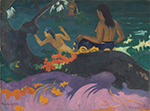
Strange Couple Over There
“'No two human beings understand each other. They
can understand but their own voices'" (115).
Points
for Reflection
Joseph Conrad's Almayer's Folly (1895), chps. 1-4
- why does Kaspar Almayer accept English sailor Captain Tom Lingard’s offer to marry Lingard’s adopted Malay daughter? Consider not only the material circumstances of the transaction, but the nature of their relationship and the two men’s respective personalities.
- the narrator tells us that Almayer used to consider his Malay
slaves “‘my own people’” (9). What do
we discover in this week’s reading that helps explain why Almayer might
no longer see the locals in this way?
- Almayer longs to take his half-caste daughter, Nina, to Europe with him, though he has never been there (despite his Dutch lineage). What does Europe represent for Almayer—why is he so drawn to this continent?
- with chapter two, Conrad begins a long flashback that reveals the history of his primary characters. He does not return to the moment with which chapter one ends until the end of chapter five. Is this an effective narratological strategy? Would it have been better storytelling to begin with the past events and then move into the present in linear fashion?
- the narrator begins the backstory of Almayer’s Malay wife
by summarily describing her people and background as “savage” (12).
In the personal history which follows, does Conrad going about deconstructing
or cementing the notion that the indigenous peoples of these islands are “savage”?
- what function does Nina play in Almayer’s life?
- does the narrative thus far encourage us to sympathize with Almayer’s wife?
- is
Almayer an ignorant innocent? Thus far we have heard quite a bit about
his unawareness of various things around him. Is he a victim
of circumstances out of his control?
- do Nina’s beliefs, her character, and/or her dreams change under the
influence of her mother? Is Nina, instead, the author of her own path and destiny?
- the narrator told us in chapter two that, as a child, Nina prefers her father to her mother. Does she show a similar preference as a young adult?
- the narrator wonders whether Taminah, the Siamese slave owned by Bulangi, avoids complaining of her ill treatment due to "the dictates of prudence" or perhaps "the strange, resigned apathy of half-savage womankind" (23). Which explanation appears more accurate as the story progresses?
- why might the narrator not immediately name either Taminah, Bulangi's Siamese slave, or Babalatchi , Lakamba's factotum, when introducing them (23-24)?
- Nina
has apparently decided that all humans—regardless of
culture, beliefs, or social practice—share the same selfish proclivities,
though she gravitates towards the “savage and uncompromising sincerity
of purpose shown by her Malay kinsmen” (27). Does the narrative to
this point encourage us to share both Nina’s cynicism and her slight
preference?
- what complex of intentions drives the upper-class Malay Dain (referred to as “Tuan Maroola” by Almayer and “A Son of Heaven” by Mrs. Almayer) to work so closely with Almayer?

By the Sea (1892)
Paul Gauguin
Dr. Paul Marchbanks
pmarchba@calpoly.edu
![]()
